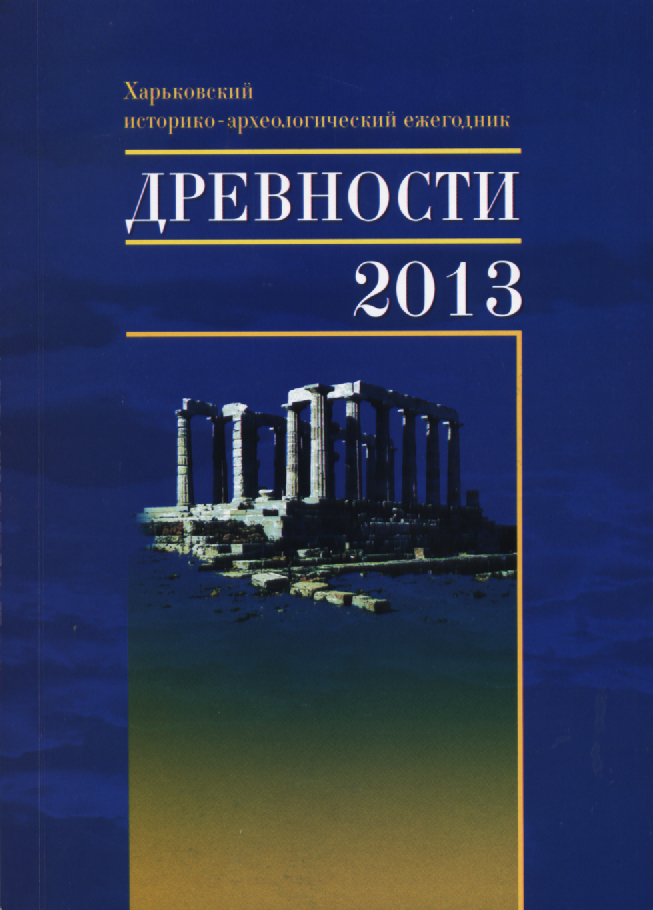Захоронения в ямах с подбоем Верхне-Салтовского катакомбного могильника (по материалам раскопок 1984–2012 гг.)
Abstract
Резюме
Хоружа М. В. Поховання у ямах з підбоєм Верхньо-Салтівського катакомбного могильника (за матеріалами розкопок 1984–2012 рр.)
В роботі розглядаються матеріали дев’яти поховань у ямах з підбоєм, котрі були досліджені на двох ділянках Верхньо-Салтівського могильника — ВСМ-I (8 комплексів) та на ВСМ-IV (1 комплекс). Більшість досліджених поховань розташовувалося на незначній відстані (2–4 м) від лівої бокової стінки дромосу катакомби, з якою вони були пов’язані. У 8 з 9 похованнях кістяки людей лежали у випростаному на спині положенні з простягнутими вздовж тіла руками та прямими ногами. Тільки в похов. № 4 підлітка було покладено з напіврозворотом на правий бік зі злегка зігнутими у колінах ногами. Череп небіжчика лежав на правій скроневій кістці та був звернений лицевим відділом на північ. Подібне розташування тіл небіжчиків з розворотом лиця на південь (на Киблу) при загальному орієнтуванні кістяка на північний захід характерно для ранніх мусульманських поховань середньої течії Сіверського Дінця. Досліджені поховання належали дітям (6 випадків) та підліткам (3 випадки). В 7 з 9 поховань був знайдений інвентар, котрий знаходить широкі аналогії в пам’ятках аланського населення салтово-маяцької культури Подоння та хозарського часу Північного Кавказу. Належність небіжчиків, що були поховані у ямах з підбоєм, до аланського етносу не викликає сумніву.
Ключові слова: салтово-маяцька культура, Верхній Салтів, поховання у ямі з підбоєм, катакомбний могильник, алани.
Summary
M. Khotyzha. Burials in Pits With Kerving of Verchne-saltovskyi (upper saltovskyi) catacomb Burial Ground (Based on excavations of 1984–2012 years)
The work represents materials of 9 burials in pits with kerving, which have been studied in two areas of Verchne-Saltovskyi (Upper Saltovskyi) catacomb burial ground — BCM-I (8 complexes) and BCM-IV (1 complex). Most of the investigated burials were located not far (2–4 m) from the dormos' left side wall of concrete catacomb burial, with which they were connected. In 8 of 9 burials, people's skeletons lay stretched out on the back with arms along the body, arms and legs were straight. Only in the burial No. 4 the dead teenager was laying half turned on the right side, with slightly bent knees. The skull of the buried rested on the right temporal bone and was directed with its facial skull to the south. A similar position of the dead people's bodies with a turn of the facial skull to the south (facing Qibla) with orienting the head of the dead to the north-west, with full absence of inventory is a characteristic of early Muslim burials at Saltovskiy monuments of the middle flow of the Seversky Donets. The investigated burials contained the remains of children (6 cases) and adolescents 12–14 years old (3 cases). In 7 of 9 burial there were funeral inventory represented. Funeral inventory finds quite wide similarities with the monuments of Alan population of Saltovo-Mayatskaya Culture of podontsovya and Khazar time from the North Caucasus territory. The belonging of these kerving burials to the representatives of Alan ethnicity is not in doubt.
Key words: Saltovo-Mayatskaya Culture, Verchne-Saltov (Upper Saltov), burial in pit with kerving, catacomb burial ground, Alan.




